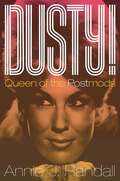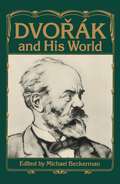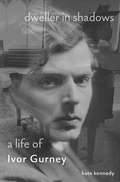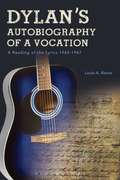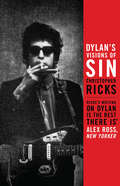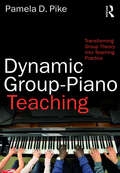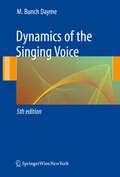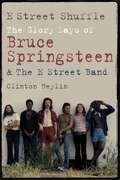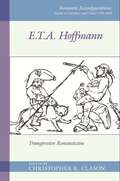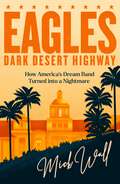- Table View
- List View
Dusty!: Queen of the Postmods
by Annie J. RandallDubbed the "White Queen of Soul," singer Dusty Springfield became the first British soloist to break into the U.S. Top Ten music charts with her 1964 hit "I Only Want To Be With You"--a pop classic followed by many others, including "You Don't Have to Say You Love Me" and "Son of a Preacher Man." Today she is usually placed within the history of the Beatles-led "British Invasion" or seen as a devoted acolyte of Motown. In this penetrating look at her music and career, Annie J. Randall shows how Springfield's contributions transcend the narrow limits of those descriptions and how this middle-class former convent girl became perhaps the unlikeliest of artists to achieve soul credibility on both sides of the Atlantic. Randall reevaluates Springfield's place in sixties popular music through close investigation of her performances as well as interviews with her friends, peers, professional associates, and longtime fans. As the author notes, the singer's unique look--blonde beehive wigs and heavy black mascara--became iconic of the mid-sixties postmodern moment in which identity scrambling and camp pastiche were the norms in swinging London's pop culture. Randall places Springfield within this rich cultural context, focusing on the years from 1964 to 1968, when she recorded her biggest international hits and was a constant presence on British television. The book pays special attention to Springfield's close collaboration and friendship with American gospel singer Madeline Bell, the distinctive way Springfield combined US soul and European melodrama to achieve her own musical style and stage presence, and how her camp sensibility figured as a key element of her artistry.
Dusty!: Queen of the Postmods
by Annie J. RandallDubbed the "White Queen of Soul," singer Dusty Springfield became the first British soloist to break into the U.S. Top Ten music charts with her 1964 hit "I Only Want To Be With You"--a pop classic followed by many others, including "You Don't Have to Say You Love Me" and "Son of a Preacher Man." Today she is usually placed within the history of the Beatles-led "British Invasion" or seen as a devoted acolyte of Motown. In this penetrating look at her music and career, Annie J. Randall shows how Springfield's contributions transcend the narrow limits of those descriptions and how this middle-class former convent girl became perhaps the unlikeliest of artists to achieve soul credibility on both sides of the Atlantic. Randall reevaluates Springfield's place in sixties popular music through close investigation of her performances as well as interviews with her friends, peers, professional associates, and longtime fans. As the author notes, the singer's unique look--blonde beehive wigs and heavy black mascara--became iconic of the mid-sixties postmodern moment in which identity scrambling and camp pastiche were the norms in swinging London's pop culture. Randall places Springfield within this rich cultural context, focusing on the years from 1964 to 1968, when she recorded her biggest international hits and was a constant presence on British television. The book pays special attention to Springfield's close collaboration and friendship with American gospel singer Madeline Bell, the distinctive way Springfield combined US soul and European melodrama to achieve her own musical style and stage presence, and how her camp sensibility figured as a key element of her artistry.
Dvorák and His World (The Bard Music Festival #31)
by Michael BeckermanAntonin Dvorák made his famous trip to the United States one hundred years ago, but despite an enormous amount of attention from scholars and critics since that time, he remains an elusive figure. Comprising both interpretive essays and a selection of fascinating documents that bear on Dvorák's career and music, this volume addresses fundamental questions about the composer while presenting an argument for a radical reappraisal. The essays, which make up the first part of the book, begin with Leon Botstein's inquiry into the reception of Dvorák's work in German-speaking Europe, in England, and in America. Commenting on the relationship between Dvorák and Brahms, David Beveridge offers the first detailed portrait of perhaps the most interesting artistic friendship of the era. Joseph Horowitz explores the context in which the "New World" Symphony was premiered a century ago, offering an absorbing account of New York musical life at that time. In discussing Dvorák as a composer of operas, Jan Smaczny provides an unexpected slant on the widely held view of him as a "nationalist" composer. Michael Beckerman further investigates this view of Dvorák by raising the question of the role nationalism played in music of the nineteenth century. The second part of this volume presents Dvorák's correspondence and reminiscences as well as unpublished reviews and criticism from the Czech press. It includes a series of documents from the composer's American years, a translation of the review of Rusalka's premiere with the photographs that accompanied the article, and Janácek's analyses of the symphonic poems. Many of these documents are published in English for the first time.
Dvorák and His World (PDF)
by Michael BeckermanAntonin Dvorák made his famous trip to the United States one hundred years ago, but despite an enormous amount of attention from scholars and critics since that time, he remains an elusive figure. Comprising both interpretive essays and a selection of fascinating documents that bear on Dvorák's career and music, this volume addresses fundamental questions about the composer while presenting an argument for a radical reappraisal. The essays, which make up the first part of the book, begin with Leon Botstein's inquiry into the reception of Dvorák's work in German-speaking Europe, in England, and in America. Commenting on the relationship between Dvorák and Brahms, David Beveridge offers the first detailed portrait of perhaps the most interesting artistic friendship of the era. Joseph Horowitz explores the context in which the "New World" Symphony was premiered a century ago, offering an absorbing account of New York musical life at that time. In discussing Dvorák as a composer of operas, Jan Smaczny provides an unexpected slant on the widely held view of him as a "nationalist" composer. Michael Beckerman further investigates this view of Dvorák by raising the question of the role nationalism played in music of the nineteenth century. The second part of this volume presents Dvorák's correspondence and reminiscences as well as unpublished reviews and criticism from the Czech press. It includes a series of documents from the composer's American years, a translation of the review of Rusalka's premiere with the photographs that accompanied the article, and Janácek's analyses of the symphonic poems. Many of these documents are published in English for the first time.
Dvorák to Duke Ellington: A Conductor Explores America's Music and Its African American Roots
by Maurice PeressDrawing upon a remarkable mix of intensive research and the personal experience of a career devoted to the music about which Dvorák so presciently spoke, Maurice Peress's lively and convincing narrative treats readers to a rare and delightful glimpse behind the scenes of the burgeoning American school of music and beyond. In Dvorák to Duke Ellington, Peress begins by recounting the music's formative years: Dvorák's three year residency as Director of the National Conservatory of Music in New York (1892-1895), and his students, in particular Will Marion Cook and Rubin Goldmark, who would in turn become the teachers of Ellington, Gershwin, and Copland. We follow Dvorák to the famed Chicago World's Fair of 1893, where he directed a concert of his music for Bohemian Honor Day. Peress brings to light the little known African American presence at the Fair: the piano professors, about-to-be-ragtimers; and the gifted young artists Paul Dunbar, Harry T. Burleigh, and Cook, who gathered at the Haitian Pavilion with its director, Frederick Douglass, to organize their own gala concert for Colored Persons Day. Peress, a distinguished conductor, is himself a part of this story; working with Duke Ellington on the Suite from Black, Brown and Beige and his "opera comique," Queenie Pie; conducting the world premiere of Leonard Bernstein's Mass; and reconstructing landmark American concerts at which George Antheil's Ballet Mecanique, George Gershwin's Rhapsody in Blue, James Reese Europe's Clef Club (the first all-black concert at Carnegie Hall), and Ellington's Black, Brown and Beige, were first presented. Concluding with an astounding look at Ellington and his music, Dvorák to Duke Ellington offers an engrossing, elegant portrait of the Dvorák legacy, America's music, and the inestimable African-American influence upon it.
Dweller in Shadows: A Life of Ivor Gurney
by Kate KennedyThe first comprehensive biography of an extraordinary English poet and composer whose life was haunted by fighting in the First World War and, later, confinement in a mental asylumIvor Gurney (1890–1937) wrote some of the most anthologized poems of the First World War and composed some of the greatest works in the English song repertoire, such as “Sleep.” Yet his life was shadowed by the trauma of the war and mental illness, and he spent his last fifteen years confined to a mental asylum. In Dweller in Shadows, Kate Kennedy presents the first comprehensive biography of this extraordinary and misunderstood artist.A promising student at the Royal College of Music, Gurney enlisted as a private with the Gloucestershire regiment in 1915 and spent two years in the trenches of the Western Front. Wounded in the arm and subsequently gassed during the Battle of Passchendaele, Gurney was recovering in hospital when his first collection of poems, Severn and Somme, was published. Despite episodes of depression, he resumed his music studies after the war until he was committed to an asylum in 1922. At times believing he was Shakespeare and that the “machines under the floor” were torturing him, he nevertheless continued to write and compose, leaving behind a vast body of unpublished work when he died of tuberculosis. Drawing on extensive archival research and spanning literary criticism, history, psychiatry and musicology, this compelling narrative sets Gurney’s life and work against the backdrop of the war and his institutionalisation, probing the links between madness, suffering and creativity.Facing death in the trenches, Gurney hoped that history might not “forget me quite.” This definitive account of his life and work helps ensure that he will indeed be remembered.
Dying, Bereavement and the Healing Arts
by Amy Kuebelbeck Julie Sanders Mike White Christopher Johns Nigel Hartley Ted Bowman Hilary Elfick Lindsay Buckell Lesley Schatzberger Mitzi Blennerhassett Ashley Barnes Christina Mason Steve Seagull Bobbie Farsides Anna Lidzey Filipa Pereira-Stubbs Kieran Walsh Judy Clinton Sinead Donnelly Sue Eckstein Monica Suswin Frans Meulenberg Oliver Samuel Kate D'Lima Robert Hamberger Corine Koppenol Paul Schatzberger Haifa Al Sanousi Yvonne Yi-Wood Mak Tim Metcalf Chris Rawlence Giles Legood Rogan Wolf River Wolton Sheelagh Gallagher Tim Jeeves Mark Cobb Kaichiro Tamba Sandra Bertman Diana Greenman John Graham-Pole David HeadThis book describes a range of successful programmes pioneered by artists, writers, nurses, musicians, therapists, social workers, and chaplains in palliative care settings. These range from simple painting and writing activities to organized communal activities like writing and performing a play.
Dylan's Autobiography of a Vocation: A Reading of the Lyrics 1965-1967
by Louis A. RenzaMany critics have interpreted Bob Dylan's lyrics, especially those composed during the middle to late 1960s, in the contexts of their relation to American folk, blues, and rock 'n' roll precedents; their discographical details and concert performances; their social, political and cultural relevance; and/or their status for discussion as "poems.†? Dylan's Autobiography of a Vocation instead focuses on how all of Dylan's 1965-1967 songs manifest traces of his ongoing, internal "autobiography†? in which he continually declares and questions his relation to a self-determined existential summons.
Dylan's Visions of Sin
by Christopher Ricks‘I consider myself a poet first and a musician second’ ‘It ain’t the melodies that’re important man, it’s the words’ Two quotes from Dylan himself that underline the importance of this book. Dylanology thrives. There is no shortage of books about him and many of them will be dusted off for his 70th birthday. This one, however, stands on its own both for its unusual approach and for the virtuosity of its execution. Ricks’s scheme, aptly, is to examine Dylan’s songs through the biblical concepts of the seven deadly Sins, the four Virtues, and the three Heavenly Graces. He carries it off with panache. Ricks may be the most eminent literary critic of his generation but nobody should feel his book is one of earnest, unapproachable exegesis, on the contrary it has a flamboyance, almost effervescence about it that is captivating. Ricks boldly and successfully judges Dylan as a poet not a lyricist and in his tour-de-force makes endless illuminating comparisons with canonical writers such as Eliot, Hardy, Hopkins and Larkin.
Dynamic Group-Piano Teaching: Transforming Group Theory into Teaching Practice
by Pamela PikeDynamic Group-Piano Teaching provides future teachers of group piano with an extensive framework of concepts upon which effective and dynamic teaching strategies can be explored and developed. Within fifteen chapters, it encompasses learning theory, group process, and group dynamics within the context of group-piano instruction. This book encourages teachers to transfer learning and group dynamics theory into classroom practice. As a piano pedagogy textbook, supplement for pedagogy classes, or resource for graduate teaching assistants and professional piano teachers, the book examines learning theory, student needs, assessment, and specific issues for the group-piano instructor.
Dynamic Group-Piano Teaching: Transforming Group Theory into Teaching Practice
by Pamela PikeDynamic Group-Piano Teaching provides future teachers of group piano with an extensive framework of concepts upon which effective and dynamic teaching strategies can be explored and developed. Within fifteen chapters, it encompasses learning theory, group process, and group dynamics within the context of group-piano instruction. This book encourages teachers to transfer learning and group dynamics theory into classroom practice. As a piano pedagogy textbook, supplement for pedagogy classes, or resource for graduate teaching assistants and professional piano teachers, the book examines learning theory, student needs, assessment, and specific issues for the group-piano instructor.
Dynamics of the Singing Voice
by Meribeth A. DaymeDuring the past decades, "Dynamics of the singing voice" has successfully been established as a reference text for teachers of singing, singers, choral conductors and organists, speech and voice therapists, laryngologists and other health professionals, psychologists and those in linguistics. It discusses the physiological, psychological, musical and emotional aspects of the voice, particularly as they relate to singing but also to speaking. The book provides a greater understanding of how the voice works and the many factors involved in singing as well as an objective discussion of singing without reference to specific techniques. In this fifth edition, the author has now updated and rearranged the content. Furthermore she has added a new chapter on vocal pedagogic aspects in order to meet the requirements of the art of singing of the 21st century. Thus this new book provides the reader with the established concepts in combination with the latest knowledge about modern approaches to the singing voice.
E-Bass für Dummies (Für Dummies)
by Patrick PfeifferAuch wenn ihm die Lead-Gitarre oft die Show stiehlt - wer sich ein wenig mit Musik auskennt, weiß, dass ohne den Bass alles nur halb so gut klingt. Schon lange sind Bassisten nicht mehr nur die Männer im Hintergrund. "E-Bass für Dummies" zeigt Ihnen anschaulich und unterhaltsam die Besonderheiten des Instruments. Patrick Pfeiffer erklärt Ihnen Schritt für Schritt, wie der E-Bass gespielt wird und was es zu Noten, Saitenspannung, Harmonien und vielem mehr zu wissen gibt. Da sind flinke oder coole Bassläufe kein Problem mehr und einer Bassistenkarriere steht nichts mehr im Wege!
E Street Shuffle: The Glory Days of Bruce Springsteen and the E Street Band
by Clinton HeylinBruce Springsteen is one of the most important and controversial rock stars of our times: this is the story of the man - a complex, poetic loner whose albums went on to sell 18 million copies - and the band that gave his inner vision a punch and a swagger. Clinton Heylin has written the most factually accurate, informative book on Springsteen to date. As in Heylin's definitive Bob Dylan title Revolution in the Air, E Street Shuffle will focus on Bruce Springsteen and his work: the songs he's written, the way they were recorded, how they sounded live. Heylin also has unparalleled access to the people around Springsteen: current and former members of the E Street Band; CBS A&R personnel; Springsteen's 'New Dylan' contemporaries, as well as fellow Asbury Park musicians and scenesters, and rock critics. This is the essential book for any fan of the Boss.Praise for Clinton Heylin:"Arguably the world's greatest rock biographer." - The Irish Independent."The only Dylanologist worth reading." - The New York Times.
E. T. A. Hoffmann: Transgressive Romanticism (Romantic Reconfigurations: Studies in Literature and Culture 1780-1850 #4)
by Christopher R. ClasonThis collection of essays addresses a very broad range of E. T. A. Hoffmann’s most significant works, examining them through the lens of “transgression.” Transgression bears relevance to Hoffmann’s life and professions in three ways. First, his official career path was that of jurisprudence; he was active as a lawyer, a judge and eventually as one of the most important magistrates in Berlin. Second, his personal life was marked by numerous conflicts with political and social authorities. Seemingly no matter where he went, he experienced much chaos, grief and impoverishment in leading his always precarious existence. Third, his works explore characters and concepts beyond the boundaries of what was considered aesthetically acceptable. “Normal” bourgeois existence was often juxtaposed to the lives of criminals, sinners, and other deviants, both within the spaces of the known world as well as in supernatural realms. He, perhaps more than any other author of the German Romantic movement, regularly portrayed the dark side of existence in his works, including unconscious psychological phenomena, nightmares, somnambulism, vampirism, mesmerism, Doppelgänger, and other forms of transgressive behavior. It is the intention of this volume to provide a new look at Hoffmann’s very diverse body of work from numerous perspectives, stimulating interest in Hoffmann in English language audiences.
Eagles - Dark Desert Highway: How America’s Dream Band Turned into a Nightmare
by Mick Wall'This could be heaven or this could be hell...'So sings Don Henley on their biggest hit, 'Hotel California', and it is true that the Eagles story was one that blurred the ultimate Hollywood highs and subterranean LA lows beyond recognition. The band that embodied the American dream with globe-straddling success, impossibly luxurious lives, almost supernatural talent also descended into nightmare with bloodletting betrayal, hate-filled hubris, the skeletons of perceived enemies, brutally discarded lovers and former band mates left unburied on the road behind them. The story of the Eagles is a truly gothic American fable: one of ultimate power and rivers of money; of sex and drugs at a time when both were the lingua-franca of sophisticated So-Cal living; of a band who sang of peaceful easy feelings in public while threatening to kill each other in private.Now, for the first time, esteemed music biographer Mick Wall will provide the definitive insight into America's bestselling band of all time, a band who have sold more records than Led Zeppelin and The Rolling Stones combined, exploring their meteoric rise to fame and the hedonistic days of the 70s music scene in LA, when American music was taking over the world.
Early '70s Radio: The American Format Revolution
by Kim SimpsonEarly '70s Radio focuses on the emergence of commercial music radio "formats," which refer to distinct musical genres aimed toward specific audiences. This formatting revolution took place in a period rife with heated politics, identity anxiety, large-scale disappointments and seemingly insoluble social problems. As industry professionals worked overtime to understand audiences and to generate formats, they also laid the groundwork for market segmentation. Audiences, meanwhile, approached these formats as safe havens wherein they could re-imagine and redefine key issues of identity. A fresh and accessible exercise in audience interpretation, Early '70s Radio is organized according to the era's five prominent formats and analyzes each of these in relation to their targeted demographics, including Top 40, "soft rock", album-oriented rock, soul and country. The book closes by making a case for the significance of early '70s formatting in light of commercial radio today.
Early '70s Radio: The American Format Revolution
by Kim SimpsonEarly '70s Radio focuses on the emergence of commercial music radio "formats," which refer to distinct musical genres aimed toward specific audiences. This formatting revolution took place in a period rife with heated politics, identity anxiety, large-scale disappointments and seemingly insoluble social problems. As industry professionals worked overtime to understand audiences and to generate formats, they also laid the groundwork for market segmentation. Audiences, meanwhile, approached these formats as safe havens wherein they could re-imagine and redefine key issues of identity. A fresh and accessible exercise in audience interpretation, Early '70s Radio is organized according to the era's five prominent formats and analyzes each of these in relation to their targeted demographics, including Top 40, "soft rock", album-oriented rock, soul and country. The book closes by making a case for the significance of early '70s formatting in light of commercial radio today.
Early English Composers and the Credo: Emphasis as Interpretation in Sixteenth-Century Music (Routledge Research in Music)
by Wendy J PorterThis book develops an innovative approach for understanding the relationship between music and words in the works of five major composers of the English Renaissance: John Taverner, Christopher Tye, John Sheppard, Thomas Tallis, and William Byrd. Focusing on these composers’ settings of the Latin Credo, the author shows how musical and linguistic emphasis can be used to understand the composers’ theological interpretations of the text. By combining markedness theory with style analysis, this study demonstrates that the composers used their musical skills not only to create beautiful music, but to raise certain elements of the text to the foreground of perception and relegate others to supporting roles, inviting listeners to experience the familiar words of the liturgy in unique ways. Providing new insights into the changing musical and religious world of the sixteenth century, this book is relevant to anyone researching music or religion in early modern England, while offering a flexible and widely adaptable tool for the analysis of musical-textual relationships.
Early English Composers and the Credo: Emphasis as Interpretation in Sixteenth-Century Music (Routledge Research in Music)
by Wendy J PorterThis book develops an innovative approach for understanding the relationship between music and words in the works of five major composers of the English Renaissance: John Taverner, Christopher Tye, John Sheppard, Thomas Tallis, and William Byrd. Focusing on these composers’ settings of the Latin Credo, the author shows how musical and linguistic emphasis can be used to understand the composers’ theological interpretations of the text. By combining markedness theory with style analysis, this study demonstrates that the composers used their musical skills not only to create beautiful music, but to raise certain elements of the text to the foreground of perception and relegate others to supporting roles, inviting listeners to experience the familiar words of the liturgy in unique ways. Providing new insights into the changing musical and religious world of the sixteenth century, this book is relevant to anyone researching music or religion in early modern England, while offering a flexible and widely adaptable tool for the analysis of musical-textual relationships.
Early English Viols: Instruments, Makers and Music (Music and Material Culture)
by Michael Fleming John BryanWinner of the Nicholas Bessaraboff Prize Musical repertory of great importance and quality was performed on viols in sixteenth- and early seventeenth-century England. This is reported by Thomas Mace (1676) who says that ’Your Best Provision’ for playing such music is a chest of old English viols, and he names five early English viol makers than which ’there are no Better in the World’. Enlightened scholars and performers (both professional and amateur) who aim to understand and play this music require reliable historical information and need suitable viols, but so little is known about the instruments and their makers that we cannot specify appropriate instruments with much precision. Our ignorance cannot be remedied exclusively by the scrutiny or use of surviving antique viols because they are extremely rare, they are not accessible to performers and the information they embody is crucially compromised by degradation and alteration. Drawing on a wide variety of evidence including the surviving instruments, music composed for those instruments, and the documentary evidence surrounding the trade of instrument making, Fleming and Bryan draw significant conclusions about the changing nature and varieties of viol in early modern England.
Early English Viols: Instruments, Makers and Music (Music and Material Culture)
by Michael Fleming John BryanWinner of the Nicholas Bessaraboff Prize Musical repertory of great importance and quality was performed on viols in sixteenth- and early seventeenth-century England. This is reported by Thomas Mace (1676) who says that ’Your Best Provision’ for playing such music is a chest of old English viols, and he names five early English viol makers than which ’there are no Better in the World’. Enlightened scholars and performers (both professional and amateur) who aim to understand and play this music require reliable historical information and need suitable viols, but so little is known about the instruments and their makers that we cannot specify appropriate instruments with much precision. Our ignorance cannot be remedied exclusively by the scrutiny or use of surviving antique viols because they are extremely rare, they are not accessible to performers and the information they embody is crucially compromised by degradation and alteration. Drawing on a wide variety of evidence including the surviving instruments, music composed for those instruments, and the documentary evidence surrounding the trade of instrument making, Fleming and Bryan draw significant conclusions about the changing nature and varieties of viol in early modern England.
The Early Film Music of Dmitry Shostakovich (Oxford Music / Media)
by Joan TitusIn the late 1920s, Dmitry Shostakovich emerged as one of the first Soviet film composers. With his first score for the silent film New Babylon (1928-29) and the many sound scores that followed, he was situated to observe and participate in the changing politics of the film industry and negotiate the role of the film composer. In The Early Film Music of Dmitry Shostakovich, author Joan Titus examines the relationship between musical narration, audience, filmmaker, and composer in six of Shostakovich's early film scores, from 1928 through 1936. Titus engages with the construct of Soviet intelligibility, the filmmaking and scoring processes, and the cultural politics of scoring Soviet film music, asking how listeners hear and see Shostakovich. The discussions of the scores are enriched by the composer's own writing on film music, along with archival materials and recently discovered musical manuscripts that illuminate the collaborative processes of the film teams, studios, and composer. The Early Film Music of Dmitry Shostakovich commingles film/media studies, musicology, and Russian studies , and is sure to be of interest to a wide audience including those in music studies, film/media scholars, and Slavicists.
The Early Film Music of Dmitry Shostakovich (Oxford Music / Media)
by Joan TitusIn the late 1920s, Dmitry Shostakovich emerged as one of the first Soviet film composers. With his first score for the silent film New Babylon (1928-29) and the many sound scores that followed, he was situated to observe and participate in the changing politics of the film industry and negotiate the role of the film composer. In The Early Film Music of Dmitry Shostakovich, author Joan Titus examines the relationship between musical narration, audience, filmmaker, and composer in six of Shostakovich's early film scores, from 1928 through 1936. Titus engages with the construct of Soviet intelligibility, the filmmaking and scoring processes, and the cultural politics of scoring Soviet film music, asking how listeners hear and see Shostakovich. The discussions of the scores are enriched by the composer's own writing on film music, along with archival materials and recently discovered musical manuscripts that illuminate the collaborative processes of the film teams, studios, and composer. The Early Film Music of Dmitry Shostakovich commingles film/media studies, musicology, and Russian studies , and is sure to be of interest to a wide audience including those in music studies, film/media scholars, and Slavicists.
The Early Flute: A Practical Guide (Cambridge Handbooks To The Historical Performance Of Music Ser.)
by Rachel BrownThis practical guide for flautists provides a survey of the instrument - its development, its technique, its repertoire and its literature - between 1700 and 1900. Each issue is set in a musical context and technical and stylistic matters such as fingering, tone production, articulation, ornamentation, vibrato, expression and delivery are examined in depth, applying evidence from historical sources to the standard flute repertoire. A series of case studies offers detailed interpretations of music by Hotteterre, Handel, Bach, Gluck, Mozart and Boehm. As an internationally recognised soloist, orchestral player and teacher of modern and historical flutes, Rachel Brown brings a wealth of experience to amateurs and professionals alike, encouraging stylistic awareness through an understanding of the way in which composers and flautists approached instruments of the past. Copious music examples, illustrations, fingering charts and bibliographies make this a standard reference book for both 'period' and modern flautists.
